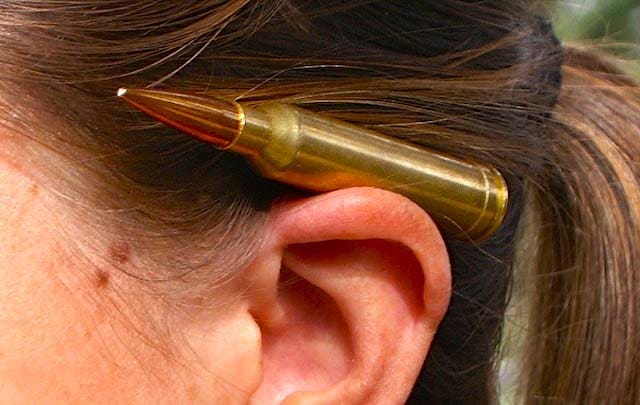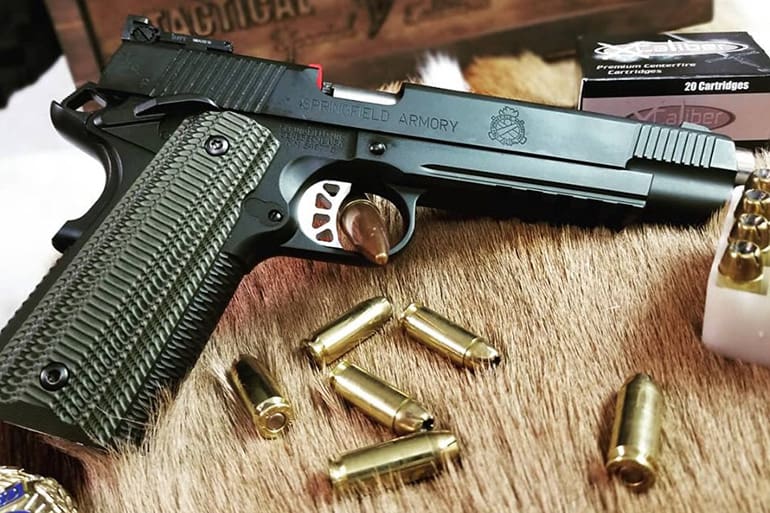NRA National Champion and trick shooter Kirsten Joy Weiss continues to fulfill her [non-statutory] obligation to answer readers’ firearms and ammo-related queries. Here’s one from the uncompromisingly unpronounceable Thpbltblt asking her recommendation for the best cartridge to shoot a quadruped from the Kingdom of Far, Far Away.
What cartridge would you recommend that can reach out and drop a bear or an elk at 500 yards, but will more realistically be used on deer at half that distance or less?
To which Ms. Weiss replies (in part): “There are a lot of different options at 500 yards for a bear. With the right Ballistic Coefficents and a MOA/Sub-MOA (MOA=inch) at 100yrd shooter, you have options. Test your gun out at the range before going after an animal though, whatever yardage you choose! That said, the most versatile hunting round I know is . . .
Click here to find out who murdered Col. Mustard in the living room with a candlestick. I mean, which cartridge Ms. Weiss favors for shooting quadrepeds.





I have never appreciated that round as much as I do now, having seen it behind the ear of a lovely, intelligent, and skilled woman. Thank you for opening my eyes, TTAG. Sigh.
Weatherby 378 Mag.
For any long range shooter, the modern formula of how to arrive at a cartridge should go like this:
1. Find a bullet you like. Look at the parameters of sectional density, Bc (G1 or G7, just use one consistently when comparing bullets, favoring G7 for very long ranges), mass, expense, etc.
2. If you’re hunting, worry about bullets that perform on game and have a slick Bc.
3. Then (and only then), worry about a cartridge to launch it.
Modern day long range shooters have three “sweet spots” in the universe of ballistic information from which to choose really slippery bullets: 6.5, 7mm and .338.
6.5mm pills in the 140 to 160gr weight range can be outstanding performers.
7mm pills in the 160 to 190gr range can be outstanding performers.
.338 pills in the 250 to 300gr range.
Now, when one starts looking about for a hunting bullet for large game in North America, you should be looking at a bullet of at least 150gr to take on “anything.” OK, so if you want at least 150, then you’re into the 7mm family, unless you want to punish yourself with the recoil generated by launching a 300gr .338 pill.
When you look at the bottle to put behind the pill, now we get into all sorts of options. Ms. Weiss’ suggestion of the 7mm RemMag is excellent, and it widely found all over the western US. Me, being an old fashioned guy, would go with a .280 Remington (.30-06 necked down to .280), and they both fit into a standard length action. The velocity difference between the two is down to about 200 fps now.
Today, there’s all manner of “super short” magnums, “ultra magnums,” blah-de-blah-blah, inserting marketing BS here. Guess what? They’re chasing the game the .284 Winchester was going after years ago.
Well said, sir, although the 6.5 mm class would be too light for the question of the post.
This question is very similar to my .338 Lapua question, and the 7mm / 300 Mag calibers are all very good solutions for the aforementioned scenario of 500 yard hunting. The .338 LM could work, but that is definitely on the heavy side (and expensive, and a ton of muzzle blast) for closer shots on deer.
One thing I would add: go to a silhouette range and bang targets from 300-600 yards. Use whatever you want for sight in and practice, but perfect your ranging and shooting with your actual hunting loads. Compensate for drop, wind, temp, etc. If you can hit a silhouette that is the same size as your game vital zone at 90% plus with your actual load / cartridge / rifle combination, than you have a good effective range. If not, move closer until you can achieve 90% hits. At 300 plus yards, hunting shots need to be taken from a stabilized position – prone, rested, shootings sticks, tripods, etc. I add running and push-ups to simulate hunting stress if I am shooting on private property or a range that doesn’t frown on such things.
I wasn’t able to achieve 90% hits with my Marlin .45-70 XLR loaded with 325 grain LeverVolution at 300 yards on a very windy day at Angeles Crest Range on silhouttes. At 200 yards, I was 100% under the same conditions. I therefore consider my .45-70 to have a 200 yard effective range until I can get more practice.
My personal choice would be a 7mm Rem Mag 168 grain VLD from Gunwerks. Second choice : the 300 Mag category with an accurate hunting bullet. Practice well, chose wisely, and you’ll have a good hunt.
Sectional density, really? The super-quality bonded hunting bullets in the past 10-15 years have relegated those trite details to the dustbin.
I say leave the hunting and hunting ammo questions to the hunters and media which specializes in it. TTAG is a great site, but it’s not a hunting site. The latest crop of long-range hunting posts may encourage some really unethical and problematic situations.
Since ballistic coefficient is basically the sectional density divided by the form factor of the bullet, there’s no way to dispense with the issue of sectional density if you want to talk about making accurate killing shots at long range. The higher the Bc, the lower the effect of wind on the bullet and the more velocity (and therefore, ability to penetrate) it retains downrange.
Hmmm. If you have to ask…
-bsd
*quadruped
First rifle I bought (and only rifle so far) is a Savage 111 synthetic (accutrigger but no accustock) in 7mm Remington Magnum. I topped it with a Nikon Buckmasters 6-18x scope and am just getting it dialed in at a hundred. Can’t wait to stretch out and try some 200, 300 and 500 yard shots with it. I chose the round under advisement from family who have taken many a deer. Glad to hear it would work for bear also.
No love for the .308… The most studied and documented round in the history of long range shooting. Sad. Everyone has magnum fever.
The .308 is awesome – and it’s hard to find ammo because of that fact. I’m having difficulty find Hornady Superperformance match and M118LR (although those are t really hunting rounds).
There’s less love for the .308 because in today’s long range market, the hot spots of bullet development aren’t in the .30 caliber area any more. They’re in the 7mm, then 6.5mm, then 6mm, then .338.
For hunting in North America, if someone wants a “one rifle to do everything” setup, I’d recommend some variant of 7mm. It could be 7mm08, .280 Rem, 7mm RemMag, 7 WSM, 7×57 Mauser, .284, etc. For those who are willing to handload, there are more excellent bullets available in the 7mm space than any other.
And no-one mentioned the 6.5-.284 wildcat. I know someone who swears by this at 400-600 metres. Unfortunately, barrel life is a bit short.
Looks like she and I have similar taste and like our independent ballistic studies have lead us to the same place. I’ve been getting it done with the 7mm Remington Magnum, with various 160gr bullets, now for 15 years on animals from skunks, coyote, pig, and deer, to elk. With many years as a hunting guide, and hunting for my own pleasure, I can’t even remember anymore how many deer have made the trip to the freezer at the end of a 7mm’s flight. I have other guns, but when I need a hunting rifle I know will get the job done, I drag out the old reliable 7mm.
What Accur81 said: PRACTICE before you try to hunt anything at 500 yards. Range and wind estimation is critical at those distances. Without a laser range finder, how good are you at telling the difference between 487 yards and 523 yards, over rough terrain that is not carefully marked off into 100-yd increments? How well do you know the ballistics of your round, and how much it drops or drifts at those ranges? Depending on the round you are using and the speed and direction of the wind, mis-estimating the longer ranges by 40-50 yards can be the difference between a clean kill and a gut shot, wounded animal.
Your performance at the 500-yard line at the shooting range is not a valid predictor of your abilities in the field. Buy a deer-size target, set it up in the woods, then walk away through moderately thick vegetative cover (going uphill or downhill if possible) to what you think is 500 yards. Run in place for a minute to max your heartbeat, then see how good a shot you are under those conditions.
Comments are closed.